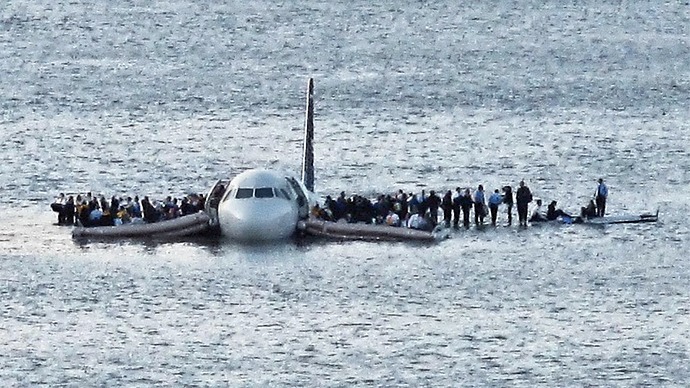US Airways 1549
US 1549, also referred to as Cactus 1549, was a scheduled flight from LaGuardia Airport (LGA/KLGA) to Charlotte Douglas International Airport (CLT, KCLT), with a final destination of Seattle-Tacoma International Airport (SEA/KSEA).
This flight was no different on January 15th, 2009. At 3:24:56 PM local time, US Airways 1549, operated by N106US, an Airbus 320-214, was cleared for takeoff from Runway 4 at New York’s LaGuardia Airport. First Officer Jeffrey Skiles was hand-flying the aircraft when the crew contacted New York Departure at 3:25:51 PM local time. Radar contact was established at 700 feet and climbing.
At 3:26:37, in a remark to First Officer Skiles, Captain Chesley Sullenberger said, “What a view of the Hudson today.” Thirty-four seconds later, at 3:27:11, N106US collided with a flock of geese at 2,818 feet. The aircraft shook violently, and a loud bang was heard. Passengers seated behind the engine reported seeing fire. A strong odor of fuel was smelt shortly after.
Captain Sullenberger immediately took control, and Skiles read through US Airways’ checklist for an engine restart. During this time, Cactus 1549 continued to climb for nineteen seconds, reaching an altitude of approximately 3,060 feet at an airspeed of 185 knots.
Unaware of the incident, New York Departure instructed US 1549 to turn left, heading two seven zero. Instead of complying, Sullenberger informed the controller of the emergency. The emergency was copied, and LGA was instructed to hold all departures. The audio recording of this part can be heard using the link below.
Portion of US Airways 1549’s Communication with ATC
The controller asked Sullenberger if he would like to return to LaGuardia during the conversation. At 3:28:05, Cactus 1549 was offered Runway 13, but instead of accepting the runway assignment, Sullenberger told the controller, “We’re unable. We may end up in the Hudson.” Runway 31 and Runway 4 were then offered, but Sullenberger did not accept.
Seconds later, Cactus 1549 was given the option to land at Teterboro Airport (TEB/KTEB) in New Jersey. Captain Sullenberger declined, however, and insisted that the aircraft was going to ditch in the Hudson. Subsequently, the controller offered the flight any runway at Newark Liberty International Airport (EWR/KEWR), but the Captain declined.
At less than 900 feet, the Airbus 320 flew over the George Washington Bridge. Sullenberger came on the aircraft’s PA system and told the cabin to brace for impact. Around the same time, ATC asked the Coast Guard to send vessels to the Hudson to assist after the aircraft had ditched.
Just after 3:31 PM, seven minutes after the aircraft left the ground at LaGuardia, US 1549 struck the frigid waters of the Hudson River. Captain Sullenberger opened the cockpit door and instructed the crew to evacuate the aircraft. Sullenberger and Skiles left the plane after confirming the cabin was empty.
Within minutes, commercial and government boats arrived at the accident scene. The Captain had advised the rescue crew to remove the people from the wings first as they were at the highest risk—the water temperature was sub-40°F—compared to those in the detachable slides.
After only 24 minutes, all 155 passengers and crew were removed from the aircraft. NYFD and subsequent forces were at the ports in both NY and NJ to help the passengers.
Out of 155 passengers, 100 were injured, 95 with minor injuries.
The rescue operation of N106US took place within hours of the accident due to the NTSB’s desire to investigate the cause as soon as possible. The aircraft was removed from the water on January 17 and placed on a barge to be transported to New Jersey pending the investigation. The left engine, which detached upon impact, was recovered five days later, on January 23.
Using the flight data recorders, ATC tapes, passengers, witnesses, crew, and simulators, the NTSB released the official report on May 4, 2010. The report identified the probable cause as “the ingestion of large birds into each engine, which resulted in an almost total loss of thrust in both engines.” The final report credited the outcome to four factors: good decision-making and teamwork by the crew (including decisions to turn on the APU immediately and to ditch in the Hudson; that the A320 is certified for extended overwater operation (and hence carried life vests and additional raft/slides) even though not required for that route; the performance of the flight crew during the evacuation; and the proximity of working vessels to the ditching site. Contributing factors were good visibility and fast response times from the ferry operators and emergency responders.
The official report can be read here.
The ditching of US Airways 1549 became known as the “Miracle on the Hudson,” as all occupants had survived. A movie based on this accident was released in 2016 by Warner Bros. Pictures and was a hit. The film detailed the accident and the investigation.
More information regarding Sully, the movie’s name, can be found in the article below.
Captain Chesley Sullenberger and First Officer Jeffrey Skiles received multiple awards for their actions, among praise from top-ranking individuals like former President Geroge Bush.
Captain Sullenberger finished his career with US Airways on March 3, 2010, while First Officer Skiles continues to fly—he’s now with American Airlines.
N106US, the aircraft involved in the accident, is currently in storage after its former home, the Carolinas Aviation Museum in Charlotte, North Carolina, closed. The aircraft will be relocated to the museum’s new location, which is still under construction, and named in Captain Sullenberger’s honor.
Well, that is the story of US Airways 1549 in a nutshell. I have always been fascinated by it, and since today is the anniversary of this miracle, I thought I’d share a rundown of the events that transpired.
Thanks for reading!
Information in this topic was gathered from Wikipedia, news reports, and the NTSB report.




